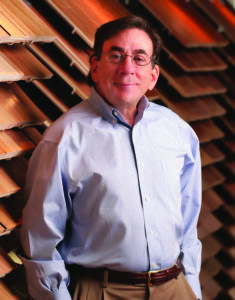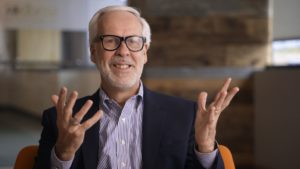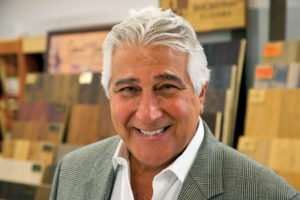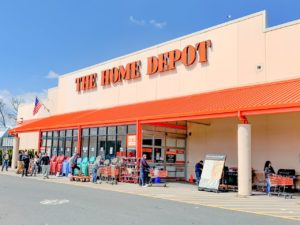Exclusive: Howard Brodsky looks back with no regrets
 After 38 years, CCA Global Partners founder and co-CEO, Howard Brodsky, is calling it a career—sort of. He will remain the chairman of the CCA board and very involved in the company.
After 38 years, CCA Global Partners founder and co-CEO, Howard Brodsky, is calling it a career—sort of. He will remain the chairman of the CCA board and very involved in the company.
“I have absolute trust and faith that Rick, as the CEO, will lead the company to even greater levels of success,” Brodsky said. “CCA’s next generation of leadership is solid, and I know our next 38 years will exceed the past. Our company is stronger than ever because our success is a real team effort.”
Brodsky recently sat down with Steven Feldman, FCNews co-publisher and editorial director, to discuss the highs and lows of Brodsky’s illustrious career. Following are excerpts of that conversation.
In the beginning…
Contents
My father was a Ukrainian refugee who came over here when he was 14. His dream was to have his own business. When I was 5, he opened a small floor covering store in Manchester.
When I was 8 I would sometimes go in with him. He was colorblind, so I would sort the tile because he couldn’t tell the colors. So my first exposure to flooring began at a young age.
He passed away from cancer when I was 13. I saw the pride he had in the store, which was doing $150,000 a year. I told my mother, “That’s what I want to do. I want to go into the business.” So my mother, who was a pharmacist and had never been in the business, stepped in and ran the business until I got out of college.
Early impacters
Back then there were regional markets. New England went to New York. The Midwest went to Chicago. There were San Francisco and Northwest markets. I went to New York once, but I heard Chicago was the better market. I went to Chicago, and that really changed my world. I met a whole new group of people, like Rick Meyer of Carpetland USA, the second largest chain in the country. Rick was my mentor. He ended up saving my business, and I ended up saving his business. Rick was brilliant, tough.
Back then the University of Indiana had a two-week graduate course in carpet retailing. It brought together an interesting group of leaders from across the country. I met a lot of the people there. There was Haig Pedian from Pedian Rug in Chicago, a very high-end rug shop in Chicago. Pat Kerns from Milwaukee, and Sam Yonan from Chicago. LaVonne Pirner. Then, of course, there was Alan Greenberg.
It was out of that group that Bill DiPaolo, who was the executive vice president of the National Home Furnishings Association, said, “There’s no major national association [for flooring].” There was the Western Floor Covering Association, but that wasn’t covering the country. He said we really should start a national trade association. That’s when I became friendly with all those people.
Sam Yonan, at his core, was all about ethics. Sam was just an enormous friend and a wonderful human being.
Pat Kerns taught me warmth and the essence of family business. He had taken over from his father, Henry Kerns. Pat was the ultimate of what community is about and what family business is about. Haig Pedian was a character. He was on the board when we started the American Floor Covering Association, and he was a great merchant.
Early lessons that stuck
Rick Meyer taught me to be hands on. You can never be so distant from the business that you can’t have a feel for what’s going on. Rick would always tell me, “Every day I want you to know these things. Not every other day. Not once a week. Every day. Don’t be somewhere where you’re not hands-on.” To that point, I’ve never had anybody answer my phone in my life. I call it a no filter. If a member has an issue, I want to hear from that member.
Alan Greenberg
 Alan and I became instant friends. We helped found the American Floor Covering Association together. We were co-chairmen of the Billion Dollar Sale, which raised the level of sales in the entire industry. We just were two peas in a pod but totally different, which is what made it good. We were totally different politically, totally different with teams.
Alan and I became instant friends. We helped found the American Floor Covering Association together. We were co-chairmen of the Billion Dollar Sale, which raised the level of sales in the entire industry. We just were two peas in a pod but totally different, which is what made it good. We were totally different politically, totally different with teams.
I was more the innovator, creator, maybe better with people, and Alan was much better operationally than I ever was, although we were both merchants. We became really bonded friends every step of the way. There was rarely a day throughout the company that we didn’t talk to each other. Saturday, Sunday. People say the goal is the most important thing, but the journey is just as important as the goal. We enjoyed the journey with each other.
There was enormous respect and trust with each other. It was 1 + 1 = 5, and we both could feel it. He brought to the table what I could never have brought to the table, and I brought to the table what he couldn’t bring to the table. There was a lot of strength. We both loved retailing and came out of retail families. We both loved the members. So it wasn’t like one was just doing this and one was doing that. The strategy and planning was both of us on almost everything.
The glimmer that became Carpet One
It came out of when we did the Billion Dollar Sale. We wanted to originally duplicate the Got Milk? campaign. The idea was if all the mills contributed X amount to a marketing campaign by the pound, the whole industry would elevate and everybody would be benefit. It turned out we had a hard time getting all the mills on board, but we figured another way to do it, which was getting all the retailers on board. We ran a huge sweepstakes and promotion, and we did an enormous amount of business without a lot of money.
Alan and I realized the strength was local. The strength was in the dealer network. It wasn’t having some powerful entity up top with a lot of money. It was all about bringing creativity and ideas for the local retailers. Alan and I said, “We had a great time doing it and were successful.” But a trade association, by nature, can only do so many things. Buying was not a typical thing in a trade association, so we said, “We have a lot of friends in this industry. If we don’t do something, we’re going to be vulnerable.” Like what the big chains did to hardware stores. We said, “We need to bring scale to the industry.”
Sandy Mishkin
Sandy is such a unique person. He was probably one of the greatest merchants ever in our industry. Sandy had a great eye for product and styling, and being a buyer that was unique. He brought a unique talent. He was also an exceptional negotiator and loved it. He had a gleam when he’d get what he wanted. At the time, there were 400 mills. It was a better time for negotiating when there were more suppliers.
Sandy was as good a negotiator as there was. You just listen and you would learn. I remember we were on a Carpet One trip to Turkey. Leather coats were a big thing. Instead of Sandy going in saying, “I want to buy a coat,” he said, “OK. How many people here want leather coats?” He was negotiating for 20 people. It was like Sandy understood what scale meant.
The shape of things
 Paul LeBlanc, who was president of Southern New Hampshire University, was an enormous entrepreneur. I was fortunate to be on the board there and still am. I’ve learned a lot from Paul: his leadership style, his vision, his empowerment of others, his talent.
Paul LeBlanc, who was president of Southern New Hampshire University, was an enormous entrepreneur. I was fortunate to be on the board there and still am. I’ve learned a lot from Paul: his leadership style, his vision, his empowerment of others, his talent.
I hired an industrial psychologist at the age of 25 because when I was starting the American Floor Covering Association, one of the members was in a board meeting and he said, “I have to go home early. I’m meeting with my psychologist.” I said, “You OK?” He said, “Well, it’s an industrial psychologist,” and I didn’t know what that was. An industrial psychologist helps businesses with the people issues, on how to hire people, how to find the best people, how to bring out the best in others. I hired a company, Nordli, Wilson, Dr. Lester Tobias, who really worked with me for a year and a half, once a week. It really taught me how to find great people.
Rick Bennet
When Alan passed away, that was probably the most critical time for the company because he was my counterbalance. It’s very rare that you find another partner. I grew up being friends with him and we became partners. That’s not going to happen at this stage. Yet, I knew it was so important, so I searched for a year with two national search agencies.
When I met Rick, I had the feeling. I interviewed some high-level executives who were presidents of large companies, and nothing quite fit because I was looking for somebody who was not just was operational but had the marketing, management, that bigger scope—and personality, someone who culturally would fit the organization. There were so many parts to it. When I met Rick, I said, “That’s it.” He was vice chairman of the May Co., but the problem was he didn’t want to come. The search firm had recommended two people that worked for him.
The early manufacturing partners who helped launch Carpet One
There were three early adopters: Don Mercer at Mohawk, Doug Foster at Salem Carpet Mills and Julian Saul at Queen Carpets. What we were doing nobody had done before. There was a fear that it was going to be all about driving price, but the reality is we ended up showing dealers how to make more money and more margin, become more professional.
Historically, independents have been losing market share to the chains in our industry. However, we have maintained or grown our market share. That’s so against the trend of where everything has gone.
Why co-op
The cooperative model is unique. There is no confusion of alignment of goals. It’s not about how much money I make. It’s about the amount of money the company makes, and it all goes back to the members. I’m sure everybody has their own reason why they do what they do, but Alan and I didn’t, nor does Rick, own one share of the company. We pay the largest percentage of rebate of any cooperative out of about 28,000 cooperatives in North America.
We believe we’ve helped the dealers make more money because of the buying, marketing, merchandising and technology. We’re in the billions of what we’ve given back in rebates. We decided early on that we didn’t want to profit from our friends. We said, “If we’re going to build an organization, we want to build it where we all own the organization.”
What is the biggest difference?
- Trust. We have an enormous amount of trust in our company–members to us, us to them.
- Mission-driven. Our employees are so mission-driven for the success of our members, and there’s a bond between members that is very unique that only a cooperative could have because it’s shared ownership.
- Our success depends purely on one thing: their success. If they’re not successful, we’re not successful. There’s no golden liquidity event of us selling. Our goal is not to build up value so we can sell it in a public market or to someone else. It’s one thing: to make our members successful, which we have been so focused on for so many years. Everybody here understands that’s our goal, to do what’s right for our members.
Carpet One turning points
- When Shaw was going to go retail, and all the members stayed strong together after we dropped them as a supplier.
- Our original goal was 300 stores and after about two or three years, we were up to 184. Alan and I said to each other, “What was 300? Why 300?” We realized we wanted a presence in every city in North America, and we wanted it for two reasons: No. 1, for the consumer; No. 2, we realized that scale was critical. I think we are the great equalizer. If you give a family business the same resources and scale—buying, marketing and technology—as a big chain, they’ll beat them every time because of the passion, the local flavor of it. I think when we decided we wanted to have a store in every market in North America, it changed our thinking of how big we would get.
- When we proved our concept to the mills with the members making much more money than they had previously. Frankly, it all comes down to the members. We knew one thing: If we could produce better profitability at the local level, the mills would understand that this wasn’t about just buying. This was as much about marketing and merchandising and technology as anything. I don’t think the mills wanted to sell to just Home Depot and Lowe’s. That’s not good to have two or three customers. But the reality was that the independent retailer was fading. Look how many retailers there were when we started. I think there were 24,000 or 28,000, and there’s about 11,000 today. Less than 50%. Now look at us: We’ve maintained a healthy market share in the community.
- As consolidation was happening, we realized we needed even more scale. It’s why Flooring America became part of CCA Global. The scale was becoming even more critical because the industry was consolidating at a very fast pace. The mills were being bought up enormously. What scale did was provide us not only a level of talent but also a level of services that we could not do previously, and it also spread the overhead.
- Diversification. We realized when we opened ProSource, when we went into the different elements, that we gave our members opportunity to expand into other market segments: ProSource, the carpet outlets, International Design Guild. We covered the spectrum from the outlet stores to the high-end designer. We ended up having more control of our own destiny at that point. Our core strength was about bringing scale to family businesses and being the great equalizer, but that was also true outside the flooring industry. We went into lighting, then bicycles, then fitness stores. Now we have Lionsbridge, which is general contractors, and we’re in the childcare world. We have the ability to give the largest rebates of any organization in North America because our overhead is spread. Also, the level of talent we can get is far superior than if we were a narrow, smaller organization.
Five early members you’ll always remember

- John and Beth Hughes from Colorado. Just a great family business, core values, committed, great people.
- The Kerns are now in the fourth generation of the company. Just warm, community-minded people. Smart but caring.
- The Murrays in Pittsburgh. Just a huge family business. Now they’re ProSource, and they’ve got Carpet One, and umpteen members of the family in the business.
- Sam Yonan, Yonan Carpets in Chicago was just a great member.
- The Pirners. LaVonne and Aaron. LaVone was a sharp, smart retailer, just astute. Always asked penetrating questions about why, what. Challenged us in a positive way.
The biggest mistake
I was running Dean’s, and I started hiring enormously talented people the industry had never seen. I had this big game plan of how we were going to expand from five stores to 20 stores. But you have to pay for talent. We probably had the talent to run 25, 30 stores, but we didn’t have the business at the time to run that many.
So even though I was an economics major I didn’t dig deep enough into the financials and got in big trouble. I was in my late 20s. I almost went out of business, and Rick Meyer showed me the way. I learned, first of all, to respect the numbers like crazy, and that I needed my counterbalance. I needed a sharp financial person internally. You can only bring on so many new people to an industry at a time. Everybody can’t be new. They can be really bright, but you need some base of industry knowledge. I was bringing them on quicker than we could train them in flooring.
Biggest changes

- The biggest change I’ve witnessed has been the home centers going from fringe to major player.
- The other big change was consolidation. Who would’ve ever thought we’d go from 400 mills to the percentage of market share the top two or three have today? That changed the game for Carpet One. It reduced the number of competitors, and we had to bring value to the mills. As the world changes, you have to bring value not only to the members but to the suppliers. One way we have done that is show them we can sell better goods, and the independent stays healthier within our organization than outside the organization.
Most proud
When I have a member come to me and say, “I wouldn’t have the business I have, I wouldn’t have the life I have, without Carpet One, without Flooring America, without International Design Guild.” Or “I never dreamed I could have this, or that my kids were going to come into the business.” When we started the business, a lot of the second and third generations were not coming into the business because they didn’t see a future. I think we provided a future for people, they saw there was opportunity. They could open up a ProSource beside their existing store, and we could show them how to grow. The success we’ve made of people, the relationships we built is what I’m most proud of.
Tunnel to Towers
 Theresa Fisher, our senior vice president of merchandising, came to me one day and said, “I just was made aware of this wonderful foundation in New York City that’s building homes for veterans who lost three or four limbs in wars. It’s so inspirational.” I said, “Let’s go,” and she ran with it. We had the vets come to our convention and you see the intestinal-fortitude of these people and their positive nature, it’s inspirational—and Frank Siller is amazing. We were able to help build these smart homes. The members install flooring free throughout the country. We’ve worked with Mohawk to supply the flooring, and we’ve worked with another supplier to provide some window treatments. I think we have made a big difference.
Theresa Fisher, our senior vice president of merchandising, came to me one day and said, “I just was made aware of this wonderful foundation in New York City that’s building homes for veterans who lost three or four limbs in wars. It’s so inspirational.” I said, “Let’s go,” and she ran with it. We had the vets come to our convention and you see the intestinal-fortitude of these people and their positive nature, it’s inspirational—and Frank Siller is amazing. We were able to help build these smart homes. The members install flooring free throughout the country. We’ve worked with Mohawk to supply the flooring, and we’ve worked with another supplier to provide some window treatments. I think we have made a big difference.
The Floor Covering Industry Foundation
Alan and I became co-chairmen. When Alan passed away, I became chairman of the FCIF for 15 years. It’s one of only two or three foundations in the U.S. that was built to take care of its own. When people have a catastrophic illness or event in the floor covering industry, whether they’re an installer, salesman, working in the factory at one of the mills, when their life is dramatically changed and can’t afford to pay their rent or to have a ramp put in or 100 different things, the FCIF has given these people a life. I’ve been thrilled to be part of that for so many years.
Advice for somebody starting out on the floor covering retail side
- Look for a mentor. There’s always somebody smarter than who you.
- You need scale. You can have independence, but in some fashion you need scale. You need to figure out how you are going to get that scale. As technology changes and consolidation happens, it’s very tough to be alone.
- You have to take some risk, and you have to look around you and see how retail is changing because we’re part of a greater industry, a fashion industry.


Comments are closed.